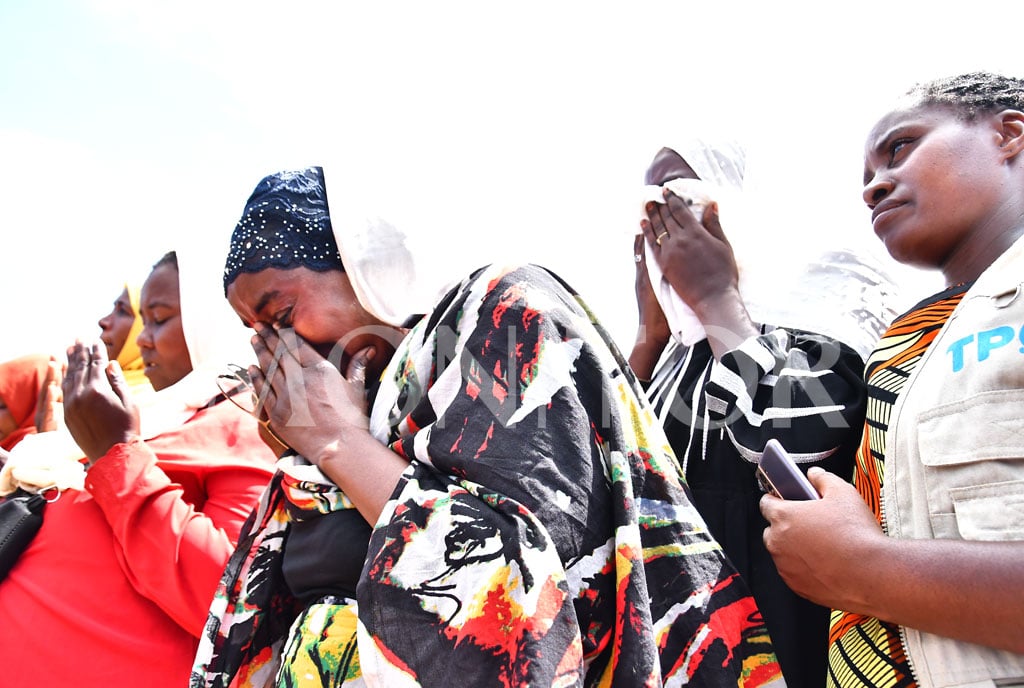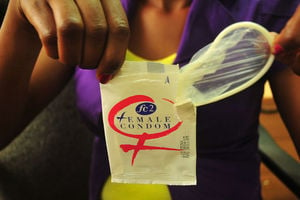
A woman cries after law enforcement used teargas to disperse refugees tussling to receive aid after humanitarian aids were delivered at a refugee camp in Kiryandongo, Bweyale District in midwestern Uganda on April 6, 2024. PHOTO/.MICHAEL KAKUMIRIZI
Victoria Lakati, a mother of three, sits in the company of seven other women on a set of benches at Awich Health Centre III at Palabek Refugee Settlement in Lamwo District.
As a counsellor under the refugee welfare committee in the settlement, Ms Lakati’s routinely conducts counselling and health talk sessions with refugee women at the settlement riddled with ever-increasing gender-based and sexual violence. Among the women in her group is Esther Nyakech, who bears a severely bruised left cheek and a swollen left arm—injuries inflicted during a domestic altercation with her husband.
The conflict erupted after Esther attended a reproductive health class at the settlement’s health centre and came home with family planning pills. Ms Nyakech and thousands of refugee women at the settlement feel the need to access family planning services but are held back by their partners.
Consequently, more than 40 percent of the women at the settlement who want to use contraceptives are unable to obtain them. While the government directs that there must be a total integration of refugee services into the public/host community services, where refugees and host communities are free to access the same services, uptake of family planning methods remains extremely low. The disparities in unmet need for family planning exist by age, education, socioeconomic status, and rural-urban geographic location.
Maternal health
Of the approximately 850,000 South Sudan refugees currently in Uganda, 83,000 of them are at the Palabek Refugee Settlement. Nearly 75 percent are either women or children. The Uganda Demographic and Health Survey (UDHS 2022) reveals that two of every 10 married women in Uganda desire to use contraception but lack access to the necessary services. The situation is exacerbated by entrenched gender inequality, harmful practices, and limited access to services.
According to the United Nations Population Fund (UNFPA), women living in rural areas have a higher unmet need of 30.1 percent compared to urban dwellers at 22.8 percent. During last month’s commemoration of World Contraceptives Day, UNFPA acknowledged that stigma and misinformation on contraception are not helping matters.
“Our goal is to see zero maternal deaths in refugee mothers and their children, including the host communities, but it is really difficult to see zero deaths when we expect a woman in labour to travel 60 kilometres to have a c-section,” Ms Juliana Lunguzi, the sexual reproductive health integration officer at UNFPA, says.
Under the UN Joint Programme to End Gender-Based Violence (GBV), UNFPA has boosted the utilisation of sexual reproductive health (SHR) services, reducing the proportion of women with unmet contraceptive needs from 39.5 percent (2018) to 20.3 percent (2024). This has triggered a spike in family planning users to 719,725 (2024) from 416,882 (2022).
This goes without saying as Uganda loses about 4,032 mothers each year due to pregnancy and birth-related complications. While maternal mortality has dropped from 336 to 189 deaths for every 100,000 live births, UNFPA says the goal is to reduce it to 70.
“No woman should die because of being pregnant. Anybody who is not 18 is a child. We should not see them getting pregnant,” Ms Lunguzi tells Sunday Monitor.
Hurdles
The government recently intensified its efforts to increase access to sexual reproductive health and rights with a special focus on family planning services nationwide. Uganda has a health structure from national to community level that has been expanding over the years in terms of capacity to ensure access to health services, including family planning. In 2019 alone, up to 73 percent of the 2.8 million women that received the various methods of contraception accessed services at the lower level health facilities (HCIIIs and HCIIs).
Dr Ocula Omoya, the Lamwo District Health Officer, notes that while refugees are free to leave the settlement to access family planning services at facilities within the host community, many remain reluctant to do so due to "communication gaps" and the influence of "traditional norms and culture."
Refugees are being taken through how best they can manage their family size to avoid some of the burdens. Despite the evidence of the early onset of sexual intercourse among adolescents, contraceptive use is low, with only 9.4 percent of young people aged 15-19 reporting the use of a modern method.
The limited engagement and support of men towards family planning has not helped matters. Consequently, since the UDHS 2001, Uganda’s mean ideal family size has not changed from around 4.8 children per woman. The desire for large families is said to be promulgated by cultural practices such as polygamy, bride price, high child mortality rates, security in having many children, and sex preference.
The 2017 Uganda’s Family Planning Cost Implementation Plan 1 (FP-CIP 1) outlines strategies to reduce the unmet need for family planning by 10 percent.

Residents gather at the commissioning of Palabek-Kal health centre in October 2024. Experts say both women and men should be educated on the use of contraceptives. PHOTO/TOBBIAS JOLLY OWINY
By the end of 2020, based on the Ministry of Health’s Family Planning 2020 Consensus Conference data, Uganda registered a modern unmet need for family planning among married women of 30.5 percent and a modern contraceptive prevalence rate (MCPR) of 38.7 percent.
That same year, the government rolled out the FP-CIP 2 (2020/21-2024/25) targeting to complete the unfinished business considering the experiences learnt and the emerging global evidence to accelerate the increase in MCPR and reduce unmet needs.
Opportunities
Uganda’s current estimated population of 45 million is projected to reach 55 million by 2030. The low contraception use has resulted in very high unintended pregnancies (44 percent), with nearly two out of five of the last pregnancies wanted later or not wanted at all. The percentage of women aged 15 to19 years who have begun childbearing by sub-region ranges from 15.5 percent (in Kigezi) to the highest at 31.4 percent (in Teso). In north Buganda (30.3 percent), Tooro (30.3 percent), Bukedi (29.5 percent), Bunyoro (29 percent) and Bugisu (28.2 percent).
The FP-CIP 2 (2020/21-2024/25) 2021 report puts the current national use of FP methods among people living with HIV/Aids at an estimated 24 percent.
“The unmet need for modern contraception, particularly among vulnerable groups, remains a critical issue. The government needs to implement comprehensive awareness campaigns to dispel myths surrounding contraception and family planning, but also invest in health infrastructure to provide quality contraceptive services,” it says.
Mr Aldon Walukamba, a documentation coordinator, believes that the solutions to attaining a healthy population count are grounded in the principles of rights and empowerment. Investing in young people, who make up more than 75 percent of Uganda’s population, and a population of 24 million women in health is particularly key, he says.
Reproductive Health Uganda (RHU) states that reducing teen pregnancies will result in greater education and economic opportunities for the young people. Meeting the reproductive rights and needs of youth through education, outreach, and access to services is imperative.
Government response
Dr Richard Mugahi, the commissioner for Reproductive, Maternal and Child Health, says while the impact of FP-CIP2 is yet to be reviewed, a positive trajectory has been registered, indicating increase in the uptake of contraceptives nationally.
“The government is putting much more funds into family planning commodities and that’s quite positive because even if the donor woke up one day and denied us funds, we would still get some supplies to our people. This financial year, a total of Shs5 billion has been committed to family planning commodities,” he says.

Refugees gesture as they prepare to receive aid after humanitarian aids were delivered at a refugee camp in Kiryandongo, Bweyale District in midwestern Uganda on April 6, 2024. PHOTO/.MICHAEL KAKUMIRIZI
Dr Mugahi blames socio-cultural factors for impeding contraceptive consumption among Ugandans. In many cultures, men believe their women should not be involved in family planning since the man is defined by the number of children they have, he says.
“There are so many cultural myths against family planning and we are now calling it healthy child spacing to avoid that stereotype,” he tells Monitor, adding, “The religious leaders, especially the Catholic leaders, came out strongly and called family planning the killing of babies, but that is not true because the sperm cells in your groin are not babies. The unfertilised eggs are not babies.”
Dr Mugahi explains that from the time a woman begins menstruating at 14 years up to the time of 49 years, every woman, on average, generates two million eggs, “so our religious leaders are telling us that all the two million eggs will become babies?” According to him, the practice of food donation to hunger-stricken communities across the country, including refugee settlements has progressively motivated uncontrolled pregnancies. In Karamoja, he says the woman who has more babies gets more food and that is why, the fertility rate is highest.
“In Ishaka (refugee settlement) in western Uganda, refugees are given food according to the number of people in the family. They give you money and family support according to the number of people you have in the family, we were there last week,” Dr Mugahi says, adding that up to 38.8 percent of women use modern family planning methods, against the national target of 50 percent. While the percentage of women with unintended pregnancies has now reduced from 28 percent five years ago to 22 percent, more women in urban areas are using modern family planning than the ones in villages.







